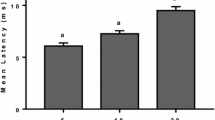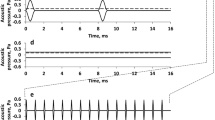Summary
-
1.
Averaged evoked potentials (AEP's) were recorded in the medulla, cerebellum, mesencephalon and telencephalon of several species of carcharhinid and triakid sharks, in the anesthetized animal with microelectrodes in the exposed brain and in the unanesthetized animal with implanted electrodes.
-
2.
A preparation is described for recording from implanted electrodes with the unanesthetized shark suspended in the water by rubber bands, subject to air- or water-borne acoustic stimuli, or electric fields or photic stimuli.
-
3.
AEP's were found in each of the levels named above, to acoustic as well as to electric and photic stimuli. The responsive loci are discrete and small. The loci of best response are distinct for each of these three modalities. Anatomical localizations are given to within about one tenth of a neuromere but rarely to the microscopic level.
-
4.
The form, latencies and recovery times of AEP's are given for the several levels and modalities. No interaction occurred between modalities at least with brief stimuli.
-
5.
The best acoustic stimulus for AEP amplitude is a “click” with a resonance of a few hundred Hz. The best tone stimulus is a rapidly rising burst of about 300 Hz. This value may be a function of size of animal, species, and electrode position. The lowest sound pressure threshold observed was −8 dB re 1 μbar near the shark's head (=66 dB SPL), to a click delivered to the water surface. We do not know the velocity-wave amplitude, although it is believed to be the more relevant quantity.
-
6.
Acoustic AEP's were markedly suppressed by background white noise or tones — best at about 100 Hz.
-
7.
When sound was delivered very locally the largest AEP occurred if the sound source was directly over the parietal fossa in the dorsal midline of the head. When sound was delivered at a distance, from a larger speaker, experimental occlusion of the parietal fossa usually suppressed the acoustic AEP. We interpret this to support the view that the fossa is an important portal for sound.
-
8.
In two experiments bilateral section of the VIIIth nerve twig to the macula neglecta, together with some incidental damage to the sacculus greatly reduced the acoustic AEP. This supports the view that the macula neglecta is an important concentration of acoustic receptors but does not definitely confirm that proposal. The evidence argues against any substantial role of the lateral line in these species in response to acoustic stimuli at low amplitudes.
Similar content being viewed by others
Abbreviations
- AEP :
-
Averaged evoked potential
References
Andrianov, G.N., Brown, H.R., Ilyinsky, O.B.: Responses of central neurons to electrical and magnetic stimuli of the ampullae of Lorenzini in the Black Sea skate. J. comp. Physiol. 95, 287–299 (1974)
Banner, A.: Evidence of sensitivity to acoustic displacements in the lemon shark, Negaprion brevirostris (Poey). In: Lateral line detectors. Cahn, P.H. (ed.), pp. 265–273. Bloomington, Indiana: Indiana University Press 1967
Banner, A.: Use of sound in predation by young lemon sharks, Negaprion brevirostris (Poey). Bull. Marine Sci. 22, 251–283 (1972)
Bennett, M.V.L.: Electroreception. In: Fish physiology, V. Hoar, W.S., Randall, D.J. Randall (eds.). New York: Academic Press 1971
Bullock, T.H.: Problems in the comparative study of brain waves. Yale J. Biol. Med. 17, 657–679 (1945)
Bullock, T.H.: Comparisons between vertebrates and invertebrates in nervous organization. In: The neurosciences, Third study program. Schmitt, F.O., Worden, F.W. et al. (eds.), pp. 343–346. Cambridge, Mass.: M.I.T. Press 1974
Bullock, T.H.: Processing of ampullary input in the brain: Comparison of sensitivity and evoked responses among elasmobranch and siluriform fishes. J. Physiol. (Paris) (in press) (1978)
Chapman, C.J., Sand, O.: Field studies of hearing in two species of flatfish Pleuronectes platessa (L.) (family Pleuronectidae). Comp. Biochem. Physiol. 47A, 371–385 (1974)
Corwin, J.T.: Morphology of the macula neglecta in sharks of the genus Carcharhinus. J. Morph. 152, 341–362 (1977)
Corwin, J.T.: The relation of inner ear structure of feeding behavior in sharks and rays. Scanning Electron Microscopy/1978 v. II, 1105–1112 (1978)
Davies, D.H., Lochner, J.P.A., Smith, E.D.: Preliminary investigations on the hearing of sharks. S. African Assoc. Marine Biol. Res., Oceanog. Res. Inst, Invest. Rep. (7), 10 pp. (1963)
Dijkgraaf, S.: Sound reception in the dogfish. Nature 197, 93–94 (1963)
Ebbesson, S.O.E.: New insights into the organization of the shark brain. Comp. Biochem. Physiol. 42A, 121–129 (1972)
Ebbesson, S.O.E., Northcutt, R.G.: Neurology of anamniotic vertebrates. In: Evolution of brain and behavior in vertebrates. Masterton, R.B., Bitterman, M.E., Campbell, C.B.G., Hotton, N. (eds.),. pp. 115–146. Hillsdale, N.J.: Lawrence Erlbaum Associates 1976
Fay, R.R.: Coding of information in single auditory-nerve fibers of the goldfish. J. Acoust. Soc. Am. 63, 136–146 (1978)
Fay, R.R., Kendall, J.I., Popper, A.N., Tester, A.L.: Vibration detection by the macula neglecta of sharks. Comp. Biochem. Physiol. 47A, 1235–1240 (1974)
Harris, G.G., van Bergeijk, W.A.: Evidence that the lateral line organ responds to near-field displacements of sound sources in water. J. Acoust. Soc. Am. 34, 1831–1841 (1962)
Kalmijn, A.J.: The detection of electric fields from inanimate and animate sources other than electric fields. In: Handbook of sensory physiology, III/3: Electroreceptors and other specialized receptors in lower vertebrates. Fessard, A. (ed.), pp. 147–200. Berlin, Heidelberg, New York: Springer 1974
Kelly, J.C., Nelson, D.R.: Hearing thresholds of the horn shark, Heterodontus francisci. J. Acoust. Soc. Am. 58, 905–909 (1975)
Kritzler, H., Wood, L.: Provisional audiogram for the shark, Carcharhinus leucas. Science 133, 1480–1482 (1961)
Lowenstein, O.: The labyrinth. In: Fish physiology, V. Hoar, W.S., Randall, D.J. Randall (eds), pp. 207–240. New York: Academic Press 1971
Lowenstein, O., Roberts, T.D.M.: The localization and analysis of the responses to vibration from the isolated elasmobranch labyrinth. A contribution to the problem of the evolution of hearing in vertebrates. J. Physiol. (Lond.) 114, 471–489 (1951)
Murray, R.W.: The ampullae of Lorenzini. In: Handbook of sensory physiology, III/3. Fessard, A. (ed.), pp. 125–146. Berlin, Heidelberg, New York: Springer 1974
Myrberg, A.A., Jr., Banner, A., Richard, J.D.: Shark attraction using a video-acoustic system. Marine Biol. 2, 264–276 (1969)
Myrberg, A.A., Jr., Ha, S.J., Walewsky, S., Banbury, J.C.: Effectiveness of acoustic signals in attracting epipelagic sharks to an underwater sound source. Bull. Marine Sci. 22, 926–949 (1972)
Myrberg, A.A., Gordon, C.R., Klimley, A.P.: Attraction of free ranging sharks by low frequency sound, with comments on its biological significance. In: Sound reception in fish. Schuijf, A., Hawkins, A.D. (eds.), pp. 205–228. Amsterdam: Elsevier 1976
Nelson, D.R.: Hearing threshods, frequency discrimination and acoustic orientation in the lemon shark, Negaprion brevirostris (Poey). Bull. Marine Sci. 17, 741–768 (1967)
Nelson, D.R., Gruber, S.H.: Sharks: attraction by low-frequency sounds. Science 142, 975–977 (1963)
Nelson, D.R., Johnson, R.H.: Acoustic attraction of Pacific reef sharks: effect of pulse intermittency and variability. Comp. Biochem. Physiol. 42A, 85–95 (1972)
Nelson, D.R., Johnson, R.H.: Some recent observations on acoustic attraction of Pacific reef sharks. In: Sound reception in fish. Schuijf, A., Hawkins, A.D. (eds.), pp. 229–239. Amsterdam: Elsevier 1976
Northcutt, R.G.: Elasmobranch central nervous system organization and its possible evolutionary significance. Am. Zool. 17, 411–429 (1977)
Northcutt, R.G.: Brain organization in the cartilaginous fishes. In: Sensory biology of sharks, skates and rays. Hodgson, E., Mathewson, R.F. (eds.). Washington, DC: U.S. Govt. Printing Office 1978
Obara, S., Bennett, M.V.L.: Mode of operation of ampullae of Lorenzini of the skate, Raja. J. Gen. Physiol. 60, 534–557 (1972)
Olla, B.: The perception of sound in small hammerhead sharks, Sphyrna lewini. M.S. Thesis, University of Hawaii 1962
Parker, G.H.: The sense of hearing in the dogfish. Science 29, 428 (1909)
Parvulescu, A.: Acoustics of small tanks. In: Marine bio-acoustics, Vol. 2. Tavolga, W.N. (ed.), pp. 1–13. Oxford: Pergamon Press 1967
Platt, C.J., Bullock, T.H., Czeh, G., Kovaćević, N., Konjević, Dj., Gojković, M.: Comparison of electroreceptor, mechanoreceptor and optic evoked potentials in the brain of some rays and sharks. J. comp. Physiol. 95, 323–355 (1974)
Popper, A.N., Fay, R.R.: Sound detection and processing by teleost fishes: a critical review. J. Acoust. Soc. Am. 53, 1515–1529 (1973)
Popper, A.N., Fay, R.R.: Structure and function of the elasmobranch auditory system. Am. Zool. 17, 443–452 (1977)
Schroeder, D.M., Ebbesson, S.O.E.: Nonolfactory telencephalic afferents in the nurse shark (Ginglymostoma cirratum). Brain Behav. Evol. 9, 121–155 (1974)
Tavolga, W.N.: Mechanisms for directional hearing in the sea catfish (Arius felis). J. Exp. Biol. 67, 97–115 (1977)
Tester, A.L., Kendall, J.I., Milisen, W.B.: Morphology of the ear of the shark genus Carcharhinus with particular reference to the macula neglecta. Pacif. Sci. 26, 264–274 (1972)
van Bergeijk, W.A.: Directional and nondirectional hearing in fish. In: Marine bio-acoustics, Vol. 1. Tavolga, W.N. (ed.), pp. 281–299. New York: Pergamon Press 1964
Wisby, W.J., Richard, J.D., Nelson, D.R., Gruber, S.H.: Sound perception in elasmobranchs. In: Marine bio-acoustics, Vol. 1. Tavolga, W.N. (ed.), pp. 255–268. New York: Pergamon Press 1964
Author information
Authors and Affiliations
Additional information
The facilities of the Mid-Pacific Marine Laboratory on Enewetak Atoll, Marshall Islands, were made available by Dr. S. Smith of the University of Hawaii. Grant support came from the National Institute of Neurological and Communicative Disorders and Stroke and the National Science Foundation.
Rights and permissions
About this article
Cite this article
Bullock, T.H., Corwin, J.T. Acoustic evoked activity in the brain in sharks. J. Comp. Physiol. 129, 223–234 (1979). https://doi.org/10.1007/BF00657658
Accepted:
Published:
Issue Date:
DOI: https://doi.org/10.1007/BF00657658




